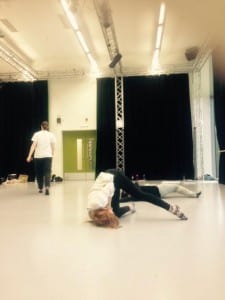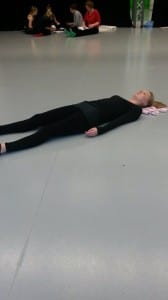Week Six 3/11/14 Going Up
In today’s session we particularly focused on giving and taking weight to enable more advance contact lifts. To begin, in partners one moved through the space whilst the other lightly traced their movement patterns by placing their hands on their different body parts. Through the light touches I could feel which of my body initiated my movements, specifically my legs and back. This task gradually developed by increasing the pressure placed onto the body, exploring where the pressure could take the movement. This intensified by using the whole the body to give and take pressure instead of the hands, in my opinion it was easier to use the whole body as movement became more fluid and smooth. What’s more the pressure from different body parts created more movement options and choices.
After experimenting with pressure we moved onto another simple task of giving and taking weight, this was in the form of one person in table top position whilst the other pressed into their back to create a back bend. When doing this it was important that the base was in a strong position to allow for the full weight of the back bend to be taken. I found that being in a strong and secure position allowed me to safely take weight of those who I would normally be the over dance for. With the back bend we played with different movements that could be created on and off the back, specifically focusing on taking the pelvis in different directions. I felt I created some interesting balances, and found different ways to move off the back.
I felt both tasks above prepared me for more advance contact lifts as I could effectively give and receive weight. One of the first lifts that we developed was a counter balance, at first we countered balanced each others weight to allow one partner to jump through the space and vice versa. This then developed into one partner being lowered to the floor to prepare for them to be pulled up and caught. At first I was hesitant to catch my partner but after a few attempts I was successful. Another lift that we encountered was a side lean, overall I found this lift easy and fun. I believe it is quite a simple lift that could be used in a free improvisation to move and direct your partner around the space.
Some of the more advance lifts consisted of a cradle and an over the back side lean. At first the cradle was relatively simple with your partner jumping into a foetal position to then be moved and spun around. However this advanced to them landing with their legs and body stretched out instead of curled inwards. I found this development difficult as I was responsible for more of my partner’s weight; hence I struggled to keep a strong base. I did enjoy this lift when I was the one being lifted. The over the back side lean lift consisted of the base lowering their pelvis and the person being lifted lifting their pelvis upwards, once this position was achieved then the base could support and lift you over their back. I found this lift quite difficult when I was the lifter.
Woodhull’s article discusses the centring of gravity and the physics behind it. This helped me to understand where my centre of gravity is during contact improvisation and how it can effect and alter my movement. Applying the knowledge from the reading to this weeks class I understood that during contact lifts my pelvis needed to be higher than my partners in order to be lifted, this then changed my centre of gravity allowing movement to happen with greater ease. In addition to this when thinking about our centre of gravity there are two forces to consider, weight and support, with an understanding of this contact improvisation can become more fluid.
Overall I found it interesting to learn a range of new and exciting lifts that can be included in contact improvisation; what’s more I found it interesting to work with different people and to push myself to be the lifter as well as the person being lifted. At the end of the class when we had a short free improvisation I did find it difficult to include some of the more advance lifts as it was hard to initiate what you wanted your partner to do without verbal communication, even if I had a clear and strong intension this at times did not translate.
Works Cited
Woodhull A. Center of Gravity. Contact Quarterly/ Contact Improvisation Sourcebook I, Vol. 4. Pp. 43-48.
 Here is an image of one of dancers moving without using her hands.
Here is an image of one of dancers moving without using her hands. Here is an image of me during the relaxation task.
Here is an image of me during the relaxation task.
Recent Comments